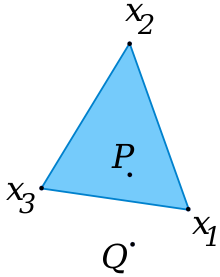- Convex combination
-
 Given three points x1,x2,x3 in a plane as shown in the figure, the point P is a convex combination of the three points, while Q is not.
Given three points x1,x2,x3 in a plane as shown in the figure, the point P is a convex combination of the three points, while Q is not.
(Q is however an affine combination of the three points, as their affine hull is the entire plane.)In convex geometry, a convex combination is a linear combination of points (which can be vectors, scalars, or more generally points in an affine space) where all coefficients are non-negative and sum up to 1.
More formally, given a finite number of points
 in a real vector space, a convex combination of these points is a point of the form
in a real vector space, a convex combination of these points is a point of the formwhere the real numbers
 satisfy
satisfy  and
and 
As a particular example, every convex combination of two points lies on the line segment between the points.
All convex combinations are within the convex hull of the given points. In fact, the collection of all such convex combinations of points in the set constitutes the convex hull of the set.
There exist subsets of a vector space that are not closed under linear combinations but are closed under convex combinations. For example, the interval [0,1] is convex but generates the real-number line under linear combinations. Another example is the convex set of probability distributions, as linear combinations preserve neither nonnegativity nor affinity (i.e., having total integral one).
Other objects
- A convex combination of probability distributions is similarly a weighted sum (where αi satisfy the same constraints as above) of its component probability distributions, with probability density function:
Related constructions
- A conical combination is a linear combination with nonnegative coefficients
- Weighted means are functionally the same as convex combinations, but they use a different notation. The coefficients (weights) in a weighted mean are not required to sum to 1; instead the sum is explicitly divided from the linear combination.
- Affine combinations are like convex combinations, but the coefficients are not required to be non-negative. Hence affine combinations are defined in vector spaces over any field.
See also
Categories:- Convex geometry
- Mathematical analysis
- Convex hulls
Wikimedia Foundation. 2010.


